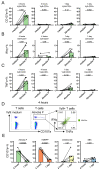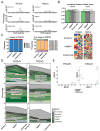Mistletoe-Extract Drugs Stimulate Anti-Cancer Vγ9Vδ2 T Cells
- PMID: 32604868
- PMCID: PMC7349316
- DOI: 10.3390/cells9061560
Mistletoe-Extract Drugs Stimulate Anti-Cancer Vγ9Vδ2 T Cells
Abstract
Human phosphoantigen-reactive Vγ9Vδ2 T cells possess several characteristics, including MHC-independent recognition of tumor cells and potent killing potential, that make them attractive candidates for cancer immunotherapeutic approaches. Injectable preparations from the hemi-parasite plant Viscum album L. (European mistletoe) are commonly prescribed as complementary cancer therapy in European countries such as Germany, but their mechanism of action remains poorly understood. Here, we investigated in-depth the in vitro response of human T cells towards mistletoe-extract drugs by analyzing their functional and T-cell-receptor (TCR) response using flow cytometry and high-throughput sequencing respectively. Non-fermented mistletoe-extract drugs (AbnobaViscum), but not their fermented counterparts (Iscador), induced specific expansion of Vγ9Vδ2 T cells among T cells. Furthermore, AbnobaViscum rapidly induced the release of cytotoxic granules and the production of the cytokines IFNγ and TNFα in Vγ9Vδ2 T cells. This stimulation of anti-cancer Vγ9Vδ2 T cells was mediated by the butyrophilin BTN3A, did not depend on the accumulation of endogenous phosphoantigens and involved the same Vγ9Vδ2 TCR repertoire as those of phosphoantigen-reactive Vγ9Vδ2 T cells. These insights highlight Vγ9Vδ2 T cells as a potential target for mistletoe-extract drugs and their role in cancer patients receiving these herbal drugs needs to be investigated.
Keywords: T cell receptor; TCR; Vgamma9Vdelta2; gammadelta; herbal drug; mistletoe.
Conflict of interest statement
The authors declare no conflict of interest.
Figures




Similar articles
-
A Structural Change in Butyrophilin upon Phosphoantigen Binding Underlies Phosphoantigen-Mediated Vγ9Vδ2 T Cell Activation.Immunity. 2019 Apr 16;50(4):1043-1053.e5. doi: 10.1016/j.immuni.2019.02.016. Epub 2019 Mar 19. Immunity. 2019. PMID: 30902636
-
TCR repertoire analysis reveals phosphoantigen-induced polyclonal proliferation of Vγ9Vδ2 T cells in neonates and adults.J Leukoc Biol. 2020 Jun;107(6):1023-1032. doi: 10.1002/JLB.1MA0120-427RR. Epub 2020 Feb 17. J Leukoc Biol. 2020. PMID: 32064671
-
Phosphoantigen Burst upon Plasmodium falciparum Schizont Rupture Can Distantly Activate Vγ9Vδ2 T Cells.Infect Immun. 2015 Oct;83(10):3816-24. doi: 10.1128/IAI.00446-15. Epub 2015 Jul 13. Infect Immun. 2015. PMID: 26169273 Free PMC article.
-
A Brief Molecular History of Vγ9Vδ2 TCR-Mediated Phosphoantigen Sensing.Immunol Rev. 2025 May;331(1):e70023. doi: 10.1111/imr.70023. Immunol Rev. 2025. PMID: 40181561 Free PMC article. Review.
-
Phosphoantigen Presentation to TCR γδ Cells, a Conundrum Getting Less Gray Zones.Front Immunol. 2015 Jan 15;5:679. doi: 10.3389/fimmu.2014.00679. eCollection 2014. Front Immunol. 2015. PMID: 25642230 Free PMC article. Review.
Cited by
-
Combined Immune Checkpoint Blockade and Helixor® Therapy in Oncology: Real-World Tolerability and Subgroup Survival (ESMO GROW).Int J Mol Sci. 2025 Apr 12;26(8):3669. doi: 10.3390/ijms26083669. Int J Mol Sci. 2025. PMID: 40332249 Free PMC article.
-
Immune Checkpoint Blockade Combined with AbnobaViscum® Therapy Is Linked to Improved Survival in Advanced or Metastatic Non-Small-Cell Lung Cancer Patients: A Registry Study in Accordance with the ESMO Guidance for Reporting Real-World Evidence.Pharmaceuticals (Basel). 2024 Dec 18;17(12):1713. doi: 10.3390/ph17121713. Pharmaceuticals (Basel). 2024. PMID: 39770555 Free PMC article.
-
In Vivo Analysis of Extract of Leaves of Mistletoe as a Benalu Duku: Clinical Chemical Value Associated with Histopathology, Liver, Kidneys, and Lethal Dose Determinate.Vet Med Int. 2022 Dec 12;2022:1182866. doi: 10.1155/2022/1182866. eCollection 2022. Vet Med Int. 2022. PMID: 36544714 Free PMC article.
-
Herb-anticancer drug interactions in real life based on VigiBase, the WHO global database.Sci Rep. 2022 Aug 19;12(1):14178. doi: 10.1038/s41598-022-17704-z. Sci Rep. 2022. PMID: 35986023 Free PMC article.
-
Viscum album Induces Apoptosis by Regulating STAT3 Signaling Pathway in Breast Cancer Cells.Int J Mol Sci. 2023 Jul 26;24(15):11988. doi: 10.3390/ijms241511988. Int J Mol Sci. 2023. PMID: 37569363 Free PMC article.
References
Publication types
MeSH terms
Substances
LinkOut - more resources
Full Text Sources
Research Materials

